NOT Black Confederates
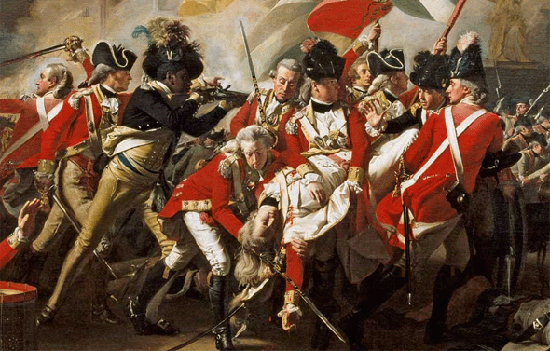
ABOVE: A cropping of The Death of Major Peirson by John Singleton Copley (Image © Tate, London 2008.) The artist painted a black soldier not present at the battle, wearing the uniform of a Royal Ethiopian. Copley knew of the Royal Ethiopian Regiment before his loyalty forced him to flee Boston. It is telling that he chose to include a Royal Ethiopian soldier in a battle at which the regiment never fought. As Black History Month comes to an end, I can't think of a better post to share today than the extraordinary story of the "Black Loyalists in New Brunswick." Without a doubt, one of the most highly controversial and contested subjects in today's historical studies (both in the public and academic arena) is the questionable history of Black "Confederates" during the American Civil War. In recent months this subject has been debated ad nauseum across the blogosphere and I touched on the subject in my recent book on Confederate encampments in Spotsylvania County.
The quarrel of course is why anyone would willingly take up arms on behalf of a cause that sought to keep them in bondage - vs. - the notion that many Africans fought beside their masters in order to protect their state's from Federal occupation. Those of you who read Campfires at the Crossroads may recall that I found the examples of black Confederates whom I cited to be slaves acting in the capacity of servants, not soldiers. The letters that I included testified to that conclusion.
Although that argument will continue for generations it seems, America's first revolution did, IN FACT, find blacks fighting alongside their white counterparts.
At the time of the Revolutionary War (1775-1783), it is estimated that there were over a half million African-Americans living in the thirteen colonies. As the rebellion's patriotic call to fight for liberty grew, the British government sought to undermine the expanding Continental Army by soliciting slaves who ran away from their masters. By promising to grant them their freedom and security, the Redcoat ranks were able to boost their manpower on the battlefield instead of constantly relying on the importation of additional troops who took months to travel to the Americas from England. Some of these all-black units even flourished as in the example of the Royal Ethiopian Regiment and later, the Black Pioneers.
According to the Atlantic Canada Virtual Archives website Black Loyalists in New Brunswick: "In November 1775, Virginia Governor Lord Dunmore, hoping to bolster the British war effort, encouraged slaves and indentured servants of the Patriots to join His Majesty's army. Many did so. When the British evacuated their army from Boston to Halifax in 1776, a "Company of Negroes" was part of the entourage. British Commander-in-Chief Sir Henry Clinton extended the policy of appealing to African Americans in his Phillipsburg Proclamation of 1779 in which he offered security behind British lines to 'every negro who shall desert the Rebel Standard.'"
Following the British Army's surrender, it is estimated that nearly 35,000 loyalists fled the United States to settle north in the provinces of Canada including the maritime regions of New Brunswick and Nova Scotia. Nearly 3,500 free black loyalists were among them including many who had fought alongside the Redcoats on behalf of the English crown. New Brunswick saw thousands of African-Americans settle in as new citizens and many went on to fight again for Britain in the War of 1812. Despite their service to the king, many black loyalists and their families still faced racial discrimination, although it paled in comparison to the institution of slavery that continued to thrive in the southern United States.
For a complete history, visit Black Loyalists in New Brunswick 1783-1854. This outstanding project is a digital collection hosted by the Atlantic Canada Virtual Archives and features document and petition transcripts, rare images, as well as lesson plans and resources for teachers.
A grand old flag
As my studies of the American Revolution continue to evolve, I find myself becoming fascinated with the flags that were used to rally both citizens and soldiers to the pursuit of liberty. The title of this blog for instance, comes from the famous “Join, or Die.” flag, based on a well-known political cartoon, created by Benjamin Franklin and first published in his Pennsylvania Gazette in May of 1754. Another flag that has caught my fancy is the “Don’t Tread on Me,” otherwise known as the Gadsden flag.
That standard in particular has become a popular symbol of Americana. I have both of these banners hanging in my cubicle at work and have seen them plastered on everything from t-shirts to bumper stickers. Those of you familiar with my editorials on the Confederate flag know that I’ve never been a fan of flags being turned into imagery on merchandise. That said, I do find it interesting that we have embraced the spirit of the Gadsden flag and made it a modern brand. It has been woven into the fabric of our culture and today we fly “Don’t Tread on Me” in celebration of our past and in dissatisfaction with our own government.
The Gadsden flag was designed by and is named after the general and statesman from South Carolina named Christopher Gadsden. In 1775, the then Colonel Gadsden, presented his design to the Continental Congress to be used as a standard by the commander of the navy. The image was immediately striking with a bright, yellow field, a graphical representation of a rattlesnake in the posture of striking, and the words "Don't Tread on Me” underneath.
As the fight for independence grew closer, the snake began to be used frequently as a symbol of the colonies and their cause. It appears on several variations of flags and one of its biggest champions, Benjamin Franklin, published an essay under the pseudonym “American Guesser,” in which he suggested that the rattlesnake was a perfect match for the American spirit. He wrote:
I recollected that her eye excelled in brightness, that of any other animal, and that she has no eye-lids—She may therefore be esteemed an emblem of vigilance.—She never begins an attack, nor, when once engaged, ever surrenders: She is therefore an emblem of magnanimity and true courage.—As if anxious to prevent all pretensions of quarreling with her, the weapons with which nature has furnished her, she conceals in the roof of her mouth, so that, to those who are unacquainted with her, she appears to be a most defenseless animal; and even when those weapons are shewn and extended for her defense, they appear weak and contemptible; but their wounds however small, are decisive and fatal:—Conscious of this, she never wounds till she has generously given notice, even to her enemy, and cautioned him against the danger of treading on her.—Was I wrong, Sir, in thinking this a strong picture of the temper and conduct of America? (Source: Franklin, Benjamin. Pennsylvania Journal. December 27, 1775)
Chris Whitten, a fellow Libertarian and Internet entrepreneur, has developed an excellent web site that deals with the complete histories of Christopher Gadsden , the Gadsden flag, and how his snake image is celebrated in our modern culture.
BELOW: Gadsden variation used by the 6th North Carolina Continental Line Regiment. (Photo by Me. "A Day in the Life of Spotsylvania," Belvedere Plantation, 2007.)
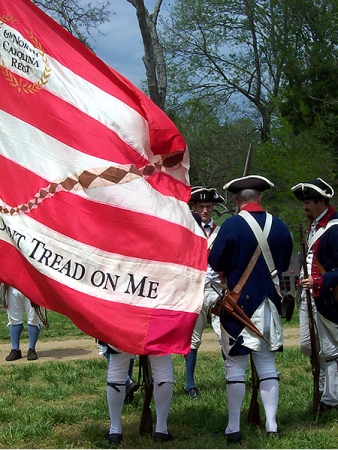
Posted by ny5/pinstripepress
at 10:01 AM EST
Updated: Saturday, 27 February 2010 3:39 PM EST
Permalink |
Share This Post
A whirlwind of writing activity
Yesterday I completed my talk and slide show for the Virginia Farm Bureau Women’s Conference Brunch on “Mary Ball Washington: Mother of the Father of our Country.” This 30-minute speech was a real challenge, but I went the extra mile on research and came up with what I think is a very solid portrait of a very complex woman. As this is to be considered a Sunday morning “devotional”, I had to write an opening prayer and find a balance between portraying Mary through a religious and secular narrative. After two drafts I was able to find a nice balance in which I present a fairly standard history lesson, while referring to documented interpretations of Mary’s spiritual-side. I enjoyed the prep-work on this one immensely and although I state no personal assumptions in my speech, I personally believe that Mary was a strong-willed and stubborn woman with a deep sense of faith.
Following the March 21 engagement, I will be sending a modified (and more scholarly) version to the folks at Patriots of the American Revolution for publication in an upcoming issue of their magazine. Last week I compiled some excellent reference for my article on George Washington and the VA Militia in western Pennsylvania, and I finally started reading Jefferson at War for an upcoming PAR book review requested by our friend Eric Wittenberg. As I will be focusing much of my time and energy on these larger pieces, I plan to post some shorter ones here on my blog. Upcoming topics include: Tar and Feathering and Loyalists. As you may have noticed, the new mantra here at “Blog, or Die.” is quality – not quantity. Stay tuned…
Posted by ny5/pinstripepress
at 11:52 AM EST
Updated: Tuesday, 23 February 2010 11:57 AM EST
Permalink |
Share This Post
Freedom of faith in Fredericksburg
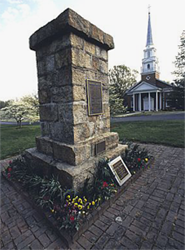 In order to understand the experiences of the historic churches of Fredericksburg, one must first look at the locality and the important role that organized religion played in the town. Today, the town is known as “America’s Most Historic City,” while the neighboring county of Spotsylvania is referred to as the “Crossroads of the Civil War.” Both are literally saturated with landmark homesteads, museums, plantations and battlefields that draw thousands of tourists each and every year. Churches remain among some of the most coveted attractions for their historical significance and architectural beauty.
In order to understand the experiences of the historic churches of Fredericksburg, one must first look at the locality and the important role that organized religion played in the town. Today, the town is known as “America’s Most Historic City,” while the neighboring county of Spotsylvania is referred to as the “Crossroads of the Civil War.” Both are literally saturated with landmark homesteads, museums, plantations and battlefields that draw thousands of tourists each and every year. Churches remain among some of the most coveted attractions for their historical significance and architectural beauty.
Fredericksburg has also been referred to as a “city of churches,” as its silhouette is dominated by a plethora of bell towers and steepled roofs. Today there are over three hundred congregations spread throughout the surrounding region. Clearly, anyone walking through the town can see the important role religion played in the day-to-day lives of the town’s inhabitants. Chartered in 1728, the settlement served as the surrounding area’s political, social and economic center. As it was conveniently located on the banks of the Rappahannock River, Fredericksburg quickly became a bustling metropolis, with taverns, lodging and commerce. Both eighteenth- and nineteenth-century industries such as mills, shipping and transportation helped to establish the town as a commercial beacon on the ever-expanding map of central Virginia.
Despite a widespread disenchantment among America’s first settlers with the Church of England, religion remained a precious keystone in colonial life. Many of the area’s first citizens still retained their belief in God and brought the deep desire to practice their faith with them when they came to this new land. It was the freedom to pursue that faith in a variety of forms that separated the early Protestant and even Catholic churches from their European counterparts. Therefore, churches were significantly important institutions in the foundation of any settlement in the New World.
The original English settlement of Fredericksburg had been clustered in a fifty-acre area along the west bank of the river. It was originally engineered in a grid-like pattern, with wide streets that were named after British royalty. The initial plot consisted of sixty-four equally sized lots with two extra spaces for a church and a market. As the population increased, Fredericksburg found it necessary to expand the municipal boundaries. By 1759, the city had tripled its physical size, opening the door to both new merchants and settlers alike. Eventually, the boundary line was pushed westward toward the area known as the “Sunken Road.” This hallowed ground witnessed the brunt of the Battle of Fredericksburg and is a national military park today.
Historically, the town of Fredericksburg is especially noteworthy with regard to all American faiths. It was here, at an establishment known as Weedon’s Tavern, where Thomas Jefferson met with his political contemporaries in 1777 and agreed to author a bill for religious liberties in America. Today, the Religious Freedom Monument stands as a testament to that event. The simple marker was first unveiled in 1932 and consists of a small obelisk made of hewn stone blocks. It is a tribute to Jefferson’s words, which resulted in the Virginia Statute of Religious Freedom:
VIRGINIA STATUTE OF RELIGIOUS FREEDOM
SECTION I. Well aware that the opinions and belief of men depend not on their own will, but follow involuntarily the evidence proposed to their minds; that Almighty God hath created the mind free, and manifested his supreme will that free it shall remain by making it altogether insusceptible of restraint; that all attempts to influence it by temporal punishments, or burthens, or by civil incapacitations, tend only to beget habits of hypocrisy and meanness, and are a departure from the plan of the holy author of our religion, who being lord both of body and mind, yet chose not to propagate it by coercions on either, as was in his Almighty power to do, but to exalt it by its influence on reason alone; that the impious presumption of legislators and rulers, civil as well as ecclesiastical, who, being themselves but fallible and uninspired men, have assumed dominion over the faith of others, setting up their own opinions and modes of thinking as the only true and infallible, and as such endeavoring to impose them on others, hath established and maintained false religions over the greatest part of the world and through all time: That to compel a man to furnish contributions of money for the propagation of opinions which he disbelieves and abhors, is sinful and tyrannical; that even the forcing him to support this or that teacher of his own religious persuasion, is depriving him of the comfortable liberty of giving his contributions to the particular pastor whose morals he would make his pattern, and whose powers he feels most persuasive to righteousness; and is withdrawing from the ministry those temporary rewards, which proceeding from an approbation of their personal conduct, are an additional incitement to earnest and unremitting labours for the instruction of mankind; that our civil rights have no dependence on our religious opinions, any more than our opinions in physics or geometry; that therefore the proscribing any citizen as unworthy the public confidence by laying upon him an incapacity of being called to offices of trust and emolument, unless he profess or renounce this or that religious opinion, is depriving him injuriously of those privileges and advantages to which, in common with his fellow citizens, he has a natural right; that it tends also to corrupt the principles of that very religion it is meant to encourage, by bribing, with a monopoly of worldly honours and emoluments, those who will externally profess and conform to it; that though indeed these are criminals who do not withstand such temptation, yet neither are those innocent who lay the bait in their way; that the opinions of men are not the object of civil government, nor under its jurisdiction; that to suffer the civil magistrate to intrude his powers into the field of opinion and to restrain the profession or propagation of principles on supposition of their ill tendency is a dangerous fallacy, which at once destroys all religious liberty, because he being of course judge of that tendency will make his opinions the rule of judgment, and approve or condemn the sentiments of others only as they shall square with or differ from his own; that it is time enough for the rightful purposes of civil government for its officers to interfere when principles break out into overt acts against peace and good order; and finally, that truth is great and will prevail if left to herself; that she is the proper and sufficient antagonist to error, and has nothing to fear from the conflict unless by human interposition disarmed of her natural weapons, free argument and debate; errors ceasing to be dangerous when it is permitted freely to contradict them.
SECTION II. We the General Assembly of Virginia do enact that no man shall be compelled to frequent or support any religious worship, place, or ministry whatsoever, nor shall be enforced, restrained, molested, or burthened in his body or goods, nor shall otherwise suffer, on account of his religious opinions or belief; but that all men shall be free to profess, and by argument to maintain, their opinions in matters of religion, and that the same shall in no wise diminish, enlarge, or affect their civil capacities.
SECTION III. And though we well know that this Assembly, elected by the people for the ordinary purposes of legislation only, have no power to restrain the acts of succeeding Assemblies, constituted with powers equal to our own, and that therefore to declare this act irrevocable would be of no effect in law; yet we are free to declare, and do declare, that the rights hereby asserted are of the natural rights of mankind, and that if any act shall be hereafter passed to repeal the present or to narrow its operation, such act will be an infringement of natural right.
The statute, enacted in 1786, separated church and state and gave equal status to all faiths. It became the basis for the First Amendment to the U.S. Constitution, giving Americans the freedom to practice the religion of their choice or none at all. Jefferson himself proclaimed this bill to be one of his three proudest achievements, alongside authoring the Declaration of Independence and founding the University of Virginia. In fact, these three accomplishments are the only ones that he deemed worthy to inscribe on his grave marker at Monticello.
Excerpt taken from "Historic Churches of Fredericksburg: Houses of the Holy" by Michael Aubrecht (History Press, 2008).
Posted by ny5/pinstripepress
at 10:39 PM EST
Updated: Saturday, 20 February 2010 10:52 PM EST
Permalink |
Share This Post
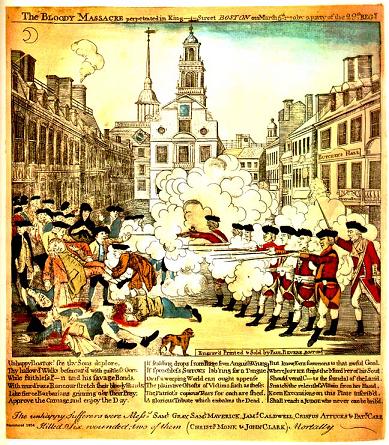







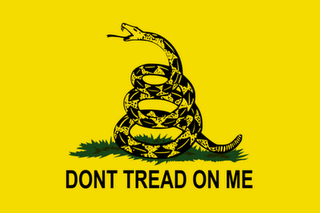

 In order to understand the experiences of the historic churches of Fredericksburg, one must first look at the locality and the important role that organized religion played in the town. Today, the town is known as “America’s Most Historic City,” while the neighboring county of Spotsylvania is referred to as the “Crossroads of the Civil War.” Both are literally saturated with landmark homesteads, museums, plantations and battlefields that draw thousands of tourists each and every year. Churches remain among some of the most coveted attractions for their historical significance and architectural beauty.
In order to understand the experiences of the historic churches of Fredericksburg, one must first look at the locality and the important role that organized religion played in the town. Today, the town is known as “America’s Most Historic City,” while the neighboring county of Spotsylvania is referred to as the “Crossroads of the Civil War.” Both are literally saturated with landmark homesteads, museums, plantations and battlefields that draw thousands of tourists each and every year. Churches remain among some of the most coveted attractions for their historical significance and architectural beauty.